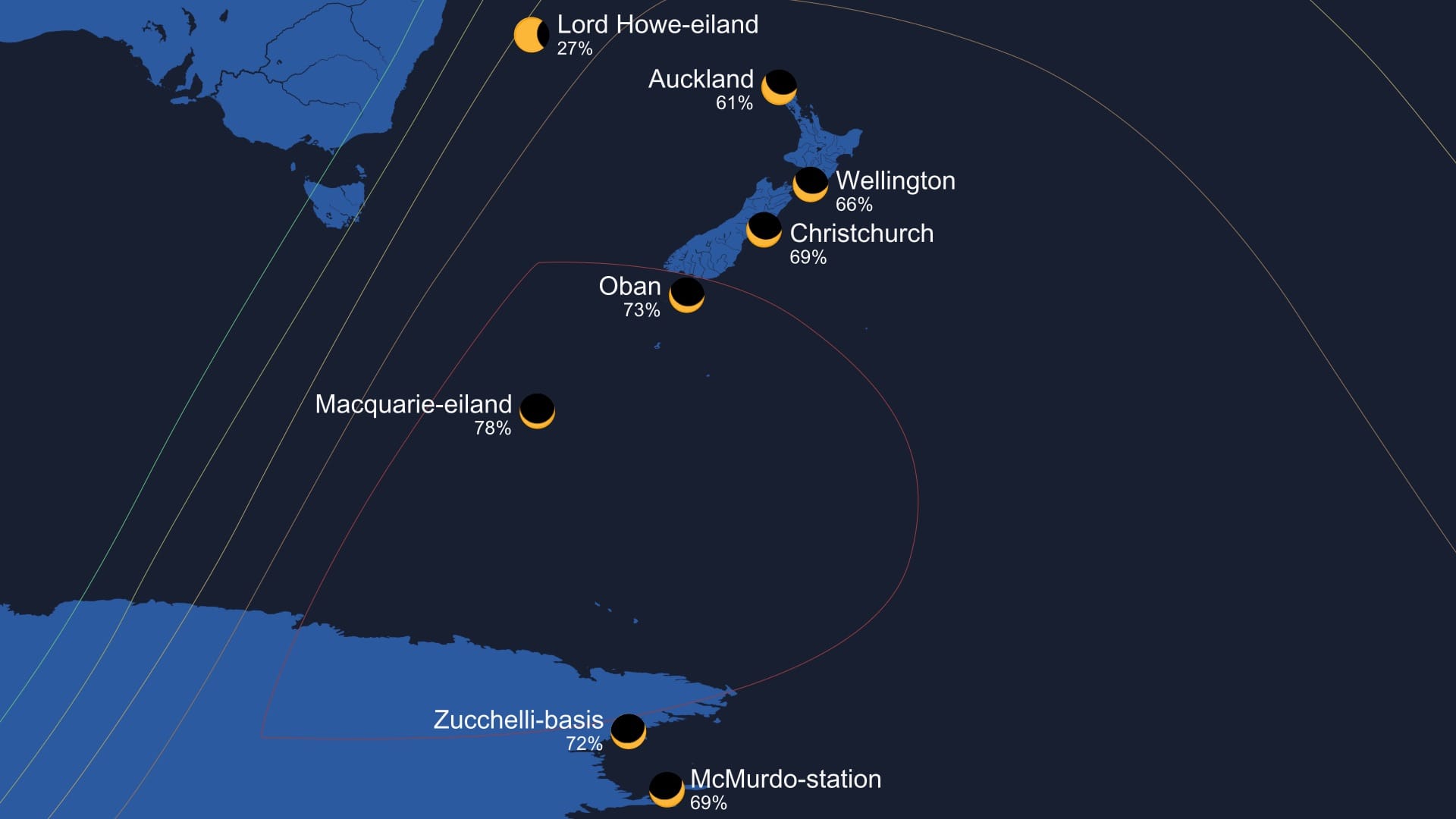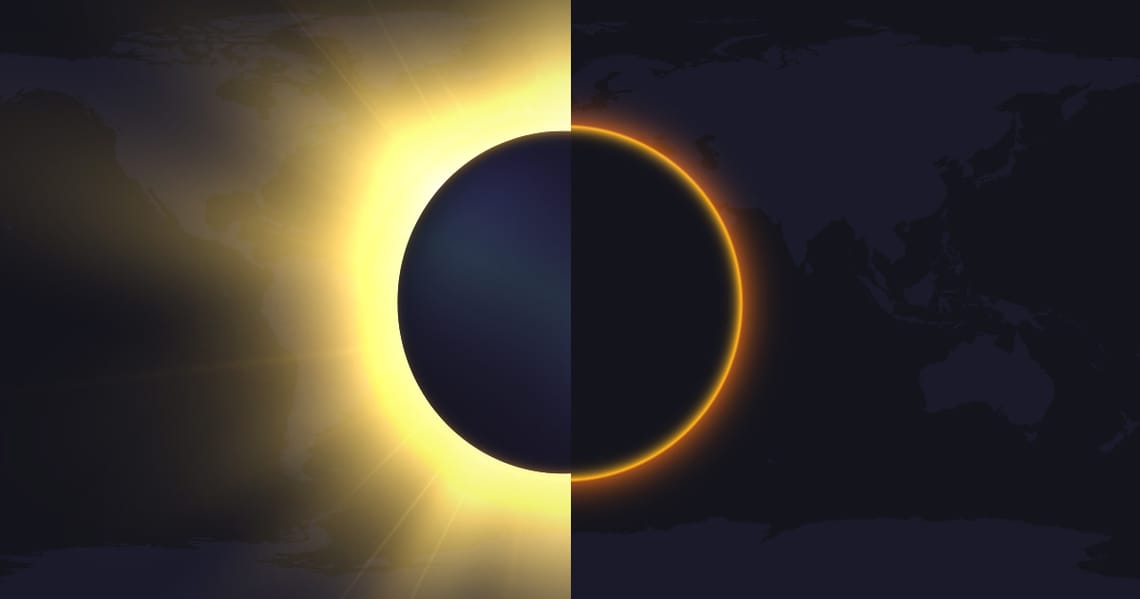Gedeeltelijke zonne-eclips 2025: wanneer & waar de “Equinox-eclips” te zien is
Op 21 september 2025 zullen vogelaars aan de hemel in Nieuw-Zeeland, delen van Australië en Antarctica een diepe gedeeltelijke zonne-eclips waarnemen. Dit evenement valt samen met het september-equinox, wat het extra bijzonder maakt. In dit artikel lees je wanneer en waar je de eclips kunt zien en wat het zo bijzonder maakt. Om eclipskaarten en tijden op maat van jouw locatie te bekijken, gebruik de app Sky Tonight.
Inhoud
- Hoe laat is de gedeeltelijke zonne-eclips in september 2025?
- Waar is de gedeeltelijke zonne-eclips van september 2025 te zien?
- Waarom is de september 2025-eclips speciaal?
- Wat is een gedeeltelijke zonne-eclips?
- Wanneer is de volgende zonsverduistering?
- Gedeeltelijke zonne-eclips september 2025: samenvatting
Hoe laat is de gedeeltelijke zonne-eclips in september 2025?
De eclips begint op 21 september om 17:29 GMT en eindigt om 21:53 GMT, en duurt ruim vier uur.
Het moment van de grootste eclips valt om 19:41 GMT, wanneer de Maan bijna 80% van de Zonneschijf bedekt boven de afgelegen Zuidelijke Stille Oceaan, halverwege tussen Nieuw-Zeeland en Antarctica. Daar is de eclips het diepst en zal de Zon verschijnen als een smalle sikkel.
De exacte tijden van de eclips verschillen per locatie. Wil je weten wanneer de eclips bij jou begint, zijn maximum bereikt en eindigt, download dan de app Eclipse Guide of Sky Tonight.
Waar is de gedeeltelijke zonne-eclips van september 2025 te zien?

Helaas zal het grootste deel van de wereld dit evenement missen — het pad van de eclips ligt in afgelegen gebieden van het zuidelijk halfrond. De beste uitzichten zijn in de zuidelijke Pacifische regio, waar de Maan het grootste deel van de Zon bedekt. De zuidelijkste punten van Nieuw-Zeeland, Stewart Island en delen van de kust van Antarctica zijn de top-locaties om de eclips in zijn diepste fase te ervaren.
Waarnemers verspreid over heel Nieuw-Zeeland zien tijdens zonsopgang op 22 september een indrukwekkende eclips. Het dekkingspercentage hangt af van de locatie en varieert grofweg tussen 60% en 73%. In Australië is de beste plek Macquarie Island, waar bijna 80% van de Zon verborgen zal zijn op het maximum. Het vasteland van Australië ligt grotendeels buiten het pad: bijvoorbeeld Sydney krijgt slechts een zeer kleine eclips van circa 1%, en Melbourne zal de eclips helemaal niet zien.
Beste locaties met kijktijden

Nieuw-Zeeland (22 september)
- Oban (Stewart Island): eclips begint om 06:37 NZST, piek om 07:14 (met 73% van de Zon bedekt) en eindigt om 08:23.
- Christchurch: eclips begint om 06:19 NZST, piek om 07:08 (met 69% van de Zon bedekt) en eindigt om 08:18.
- Wellington: eclips begint om 06:10 NZST, piek om 07:04, en eindigt om 08:15, met 66% van de Zon bedekt.
- Auckland: eclips begint om 06:10 NZST, piek om 06:55 (met 61% van de Zon bedekt) en eindigt om 08:04.
Australië (22 september)
- Macquarie Island: eclips begint om 05:13 MIST, piek om 05:28 (met 78% van de Zon bedekt) en eindigt om 06:36.
- Lord Howe Island: eclips begint om 05:43 LHST, piek om 05:46 (met 27% van de Zon bedekt) en eindigt om 06:16.
Antarctica (22 september)
- Zucchelli Station: eclips begint om 07:05 NZST, piek om 08:10 (met 72% van de Zon bedekt) en eindigt om 09:17.
- McMurdo Station: eclips begint om 07:11 NZST, piek om 08:16 (met 69% van de Zon bedekt) en eindigt om 09:23.
Waarom is de september 2025-eclips speciaal?
Deze eclips valt op door meerdere redenen:
- Diepe gedeeltelijke eclips — met tot wel 80% van de Zonneschijf bedekt is het een van de meest indrukwekkende gedeeltelijke eclipsen van dit decennium.
- “Equinox-eclips” — de eclips vindt vlak vóór het september-equinox plaats, wanneer dag en nacht bijna overal op aarde gelijk zijn, wat het extra symbolische waarde geeft.
- Unieke kans voor Nieuw-Zeeland — in tegenstelling tot veel zuidelijke eclipsen die boven open oceaan of Antarctica plaatsvinden, brengt deze een diepe eclips naar bevolkte gebieden van Nieuw-Zeeland. Bovendien valt hij slechts twee weken na een totale maansverduistering op 7 september, die ook vanaf die regio zichtbaar was.
Wil je meer leren over eclipsen op een leuke manier? Doe onze eclips-quiz om je kennis te testen en leuke feiten te ontdekken!

Wat is een gedeeltelijke zonne-eclips?
Een gedeeltelijke zonne-eclips ontstaat wanneer de Maan slechts een deel van de Zonneschijf bedekt. In tegenstelling tot een totale of ringvormige eclips wordt de Zon nooit volledig verduisterd. Toch kan tijdens een diepe gedeeltelijke eclips zoals die van 21 september het daglicht merkbaar dimmen, wat een bijna surrealistische sfeer creëert. Lees ons speciale artikel om meer te weten te komen over de verschillende soorten zonne-eclipsen.
Belangrijk: kijk nooit direct naar de Zon zonder geschikte oogbescherming. Gebruik gecertificeerde eclipsbrillen of zonnefilters — gewone zonnebrillen bieden geen veilige bescherming.
Wanneer is de volgende zonsverduistering?
Na september 2025 vindt de volgende zonsverduistering plaats op 17 februari 2026. Dat wordt een ringvormige (anulaire) eclips, zichtbaar als een “ring van vuur” uitsluitend vanaf Antarctica.
Vervolgens, op 12 augustus 2026, volgt een totale zonsverduistering. Deze is zichtbaar vanaf delen van Rusland, Groenland, IJsland en Spanje. Een gedeeltelijke eclips zal in grote delen van Europa, Afrika en Noord-Amerika te zien zijn.
Bekijk onze eclips-infographic voor meer informatie over aankomende zon- en maansverduisteringen.

Gedeeltelijke zonne-eclips september 2025: samenvatting
De gedeeltelijke zonne-eclips op 21 september 2025 wordt een diepe eclips, het best zichtbaar vanuit Nieuw-Zeeland en delen van Antarctica, waarbij de Maan tot 80% van de Zonneschijf kan bedekken. De toevallige samenloop met het september-equinox maakt het extra bijzonder. Om je kijkplannen te maken en de exacte tijden voor jouw locatie te vinden, gebruik de apps Eclipse Guide of Sky Tonight. En vergeet je eclipsbril niet!
